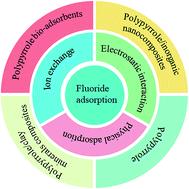Application of polypyrrole-based adsorbents in the removal of fluoride: a review
Abstract
When fluoride levels in water exceed permitted limits (>1.5 mg L−1), water pollution becomes a major concern to humans. As a result, the adsorption method is the most optimal approach for treating fluorinated water due to its low cost, availability of adsorbents, pollution-free treated water, and environmental friendliness. Historically, alumina and aluminum-based adsorbents, bio-adsorbents, ion-exchange resins, calcium-based materials, carbon-based adsorbents, and polymer-based adsorbents have all been studied for the removal of fluoride ions from aqueous/wastewater. Conducting polymer-based composites have recently received a lot of attention because of their simplicity of synthesis and biocompatibility, and they could be used to treat fluoride ions. This review summarizes the physico-chemical properties, adsorption characteristics, and mechanism of various polypyrrole-based adsorbents, such as PPy/biosorbents, polypyrrole/clay mineral composites, polypyrrole/common metallic oxide composites, and polypyrrole/magnetic nanoparticles, as well as their applications in the removal of fluoride ions.

- This article is part of the themed collection: 2022 Reviews in RSC Advances


 Please wait while we load your content...
Please wait while we load your content...